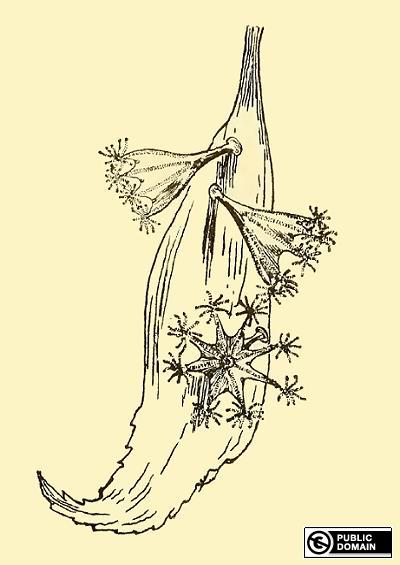STAUROMEDUSAE UK
An online guide to the Stalked jellyfish (Stauromedusae) found
around the coastal waters of the United Kingdom and Ireland.
Includes notes on their identification, and where and how to find them.
Generic Character: Body somewhat campanulate, fixed when at rest by a narrow disc or stalk ; mouth quadrangular, in the centre of a reversed umbrella-like expansion; tentacula disposed in widely separate tufts on the margin.
L. auricula.
Body funnel-shaped, with eight equidistant tufts of tentacula round the margin; between each tuft a marginal tubercle.
PI. xvi., figs. 1, 2, 3.
Lucernaria auricula, Turton's Lin., vol. 4, p. 121. Fleming's Brit. An., p. 499. Johnston in Mag. Nat. Hist., vol. 5, p. 44; Brit. Zoopb., p. 229, fig. 35, p. 230, fig. 36, p. 193, fig. 28. Templeton in Mag. Nat. Hist., vol. 9, p. 304.
Hab. On fuci, at Talland sand bay, Chapel pits, Polperro.
Abundant about June, July, and August.
This species I have found abundant in some years, while in others, I have hardly been able to procure a single specimen. Though I have supposed it the L. auricula of the authors quoted above, yet it differs in some important particulars. The form of the body very much resembles the conoidal, or old form of wine glasses; the upper and free margin is surrounded by eight equi-distant tufts of tentacula.
From each of these tufts of suckers a thick chain of brown glandular looking bodies proceeds downwards, for about two-thirds the length of the body, where they unite in pairs, and then proceed as a very delicate thread to the base. The foot-stalk is small and tubular, resembling the stalk of a wine glass, and under certain lights appears to be annular, or to have a spiral thread running its whole length. The termination of this foot-stalk is in a flat cup-like disc, by which it adheres to the fucus on which it stands. Between each pair of tufts of tentacula is a marginal gland. The mouth is central, elevated, and somewhat quadrangular. At the four angular
projections of the lip are four bodies attached externally, rounded superiorly, and pointed inferiorly. The colour is generally of a reddish brown, but is sometimes of a liver brown, green, or yellowish.
They fix themselves to the fuci by their sucker-like discs, in nearly an erect position; never, however, hanging down or standing perfectly erect. Their mode of progression differs under different circumstances. If intending to move to any great distance, they do so by loosening their attachments, and then by various and active contortions, waft themselves away till they meet with an obstruction; there they rest, and if the situation suits, they fix themselves, if not they move on in the same manner to some other spot. If the change be only for a short distance, as from one part of the leaf to another, they bend their campanulate rims and bring the tentacula
in contact with the fucus, and by them adhere to it ; the foot-stalk is then loosened, thrown forward, and twirled about, till it meets with a place to suit it; it is then fixed and the tentacula are loosened, and in this way they move from one spot to another. They sometimes also move like the Actiniae by a gliding motion of the stalk. In taking their prey they remain fixed, with their tentacula expanded, and if any minute substance comes in contact with any of the tufts, that tuft contracts, and is turned to the moutb, while the others remain expanded watching for prey.
The differences between this and Dr. Johnston's specimens are as follows. The brown glandular bodies of the free rim proceed from the tentacula in this, while in Dr. J.'s there is a slight distance between them ; this may arise from the advanced state of the ova in my specimens. In this the chains of glands from the tentacula unite in pairs at three-fourth's of the length of the body ; in the others they proceed singly to the base. In this, the footstalk is distinctly separate from the campanulate rim, in Dr. Johnston's it is said to be sessile, and there is no distinction between the base and the other part. The peduncle, or foot, terminates in a flat, suckerlike
expansion while in the other, both in the figures and description, it is absent. These characters have not been observed in a single specimen only, but in scores, and may therefore be considered permanent variations or characters.
Ref: A Cornish Fauna Part III The Zoophytes and Calcareous Corallines by Richard Q. Couch, M.R.C.S.L.. Page 83-4.
